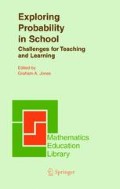Access this chapter
Tax calculation will be finalised at checkout
Purchases are for personal use only
Preview
Unable to display preview. Download preview PDF.
References
Benson, C. T., & Jones, G. A. (1999). Assessing students' thinking in modeling probability contexts. The Mathematics Educator, 4(2), 1–21.
Biggs, J. B., & Collis, K. F. (1991). Multimodal learning and the quality of intelligent behavior. In H. A. Rowe (Ed.), Intelligence: Reconceptualization and measurement. Hillsdale, NJ: Erlbaum.
Carpenter, T. P., & Fennema, E. (1988). Research and cognitively guided instruction. In E. Fennema, & T. P. Carpenter (Eds.), Integrating research on teaching and learning mathematics (pp.2–17). Wisconsin: Wisconsin Center for Education Research.
Case, R. (1996). Reconceptualizing the nature of children's conceptual structures and their development in middle childhood. Monographs of the Society for Research in Child Development, 61, (1–2, Serial No.246), 1–26.
Cobb, P. (2000). Conducting teaching experiments in collaboration with teachers. In A. Kelly & R. Lesh (Eds.), Hand book of research design in mathematics and science education (pp.307–333), Mahwah, NJ: Erlbaum Associates.
English. L.D (1990). Young children's combinatoric strategies. Educational Studies in Mathematics, 22, 451–474.
English, L.D (1993). Children's strategies for solving two-and three-dimensional combinatorial problems. Journal for Research in Mathematics Education, 22, 255–273.
Fischbein, E., & Schnarch, D (1997). The evolution with age of probabilistic, intuitively based misconceptions. Journal for Research in Mathematics Education, 28, 96–105.
Green, D. R. (1983). A survey of probability concepts in 3,000 pupils aged 11–16 years. In D. R. Grey, P. Holmes, F. Barnett, & G. M. Constable (Eds.), Proceedings of the First International Conference on Teaching Statistics (pp.766–783). Sheffield, England: Teaching Statistics Trust.
Hogg, R. V., & Tanis, E. A. (1997). Probability and statistical inference (5th ed.). Upper Saddle River, NJ: Prentice Hall.
Jones, G. A., Langrall, C. W., Thornton, C.A., & Mogill, A. T. (1997). A framework for assessing and nurturing young children's thinking in probability. Educational Studiesin Mathematics, 32, 101–125.
Jones, G. A., Langrall, C. W., Thornton, C. A., & Mogill, A. T. (1999). Students' probabilistic thinking in instruction. Journal for Research in Mathematics Education, 30, 487–519.
Jones, G. A., Thornton, C. A., Langrall, C. W., & Tarr, J. E. (1999). Understanding students' probabilistic reasoning. In L. V. Stiff, & F. R. Curcio (Eds.), Developing mathematical reasoning in Grades K-12: 1999 Yearbook (pp.l46–155). Reston, VA: National Council of Teachers of Mathematics.
Lamon, S. J. (1999). Teaching fractions and ratios for understanding: Essential content knowledge and instructional strategies for teachers. Mahawh, NJ: Erlbaum Associates.
Lecoutre, M. P. (1992). Cognitive models and problem spaces in "purely random" situations. Educational Studies in Mathematics, 23, 557–568.
National Council of Teachers of Mathematics (2000). Curriculum and evaluation standards for school mathematics. Reston, VA: Author.
Piaget, J., & Inhelder, B. (1975). The origin qfthe idea of chance in students (L. Leake, Jr., P. Burrell, & H. D. Fischbein, Trans). New York: Norton (Original work published 1951)
Polaki, M. V., Lefoka, P.J., & Jones, G. A. (2000). Developing a cognitive framework for describing and predicting Basotho students' probabilistic thinkmg. Boleswa Educational Research Journal, 17, 1–21.
Polaki, M. V. (2002a). Using instruction to identify mathematical practices associated with Basotho elementary students' growth in probabilistic reasoning. Canadian Journal of Science, Mathematics and Technology Education, 2, 357–370.
Polaki, M. V. (2002b). Using instruction to identify key features of Basotho elementary students' growth in probabilistic thinking. Mathematical Thinking and Learning, 4, 285–314.
Pratt, D. (2000). Making sense of the total of two die. Journal for Research in Mathematics Education, 31, 602–625.
Simon, M. A. (1995). Reconstructing mathematics from a constructivist pedagogy. Journal for Research in Mathematics Education, 26,146–149.
Singer, J.A., Resnick, L. B. (1992). Representations of proportional relationships: Are children part-part or part-whole reasoners? Educational Studies in Mathematics, 23, 231–246.
Speiser, R., & Walter, C. (1998). Two dice, two sample spaces. In L. Pereira-Mendoza, L. Seu Kea, T. Wee Kee, & W. K. Wong (Eds.), Proceedings of the Fifth International Conference on the Teaching of Statistics (Vol. 1, pp. 1041–1047). Voorburg, The Netherlands: International Statistical Institute.
Vidakovic, D. (1998). Children's intuition of probabilistic concepts emerging from fair play. In L. Pereira-Mendoza, L. Seu Kea, T. Wee Kee, & W. K. Wong (Eds.), Proceedings of the Fifth International Conference on the Teaching of Statistics (Vol. 1, pp. 67–73). Voorburg, The Netherlands: International Statistical Institute.
Watson, J. D., Collis, K. F., & Moritz, J. B. (1997). The development of chance measurement. Mathematics Education Research Journal, 9, 60–82.
Watson, J. D., & Moritz, J. B. (1998). Longitudinal development of chance measurement. Mathematics Education Research Journal, 10, 103–127.
Zimmerman, G. M. & Jones, G. A. (2002). Probability simulation: What meaning does it have for high school students. Canadian Journal of Science, Mathematics, and Technology Education, 2, 221–237.
Editor information
Editors and Affiliations
Rights and permissions
Copyright information
© 2005 Springer Science+Business Media, Inc.
About this chapter
Cite this chapter
Polaki, M.V. (2005). Dealing with Compound Events. In: Jones, G.A. (eds) Exploring Probability in School. Mathematics Education Library, vol 40. Springer, Boston, MA. https://doi.org/10.1007/0-387-24530-8_9
Download citation
DOI: https://doi.org/10.1007/0-387-24530-8_9
Publisher Name: Springer, Boston, MA
Print ISBN: 978-0-387-24529-4
Online ISBN: 978-0-387-24530-0
eBook Packages: Humanities, Social Sciences and LawEducation (R0)

